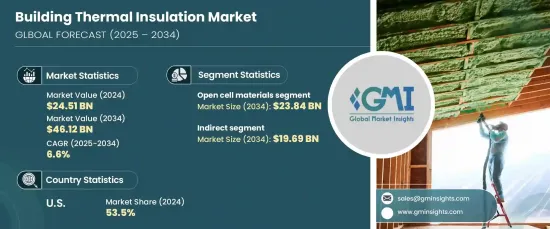
세계 건축용 단열재 시장은 2024년 245억 1,000만 달러 규모에 달할 것으로 예상되며, 2025년부터 2034년까지 연평균 6.6%의 성장률을 보일 것으로 예상됩니다.
환경 의식 증가와 기후 변화에 대한 우려로 인해 건설 분야에서 에너지 효율이 높은 솔루션에 대한 수요가 증가하고 있습니다. 건축물은 상당한 에너지 소비를 차지하며, 단열재는 냉난방의 필요성을 줄이고 온실 가스 배출을 효과적으로 줄일 수 있습니다. 이는 전 세계의 지속가능성에 대한 노력과 일치하며, 친환경 단열재의 채택을 촉진하고 있습니다.

소비자, 개발자 및 계약자들은 점점 더 지속 가능하고 에너지 효율적인 옵션을 선호하고 있으며, 이는 천연 및 재활용 재료로 만든 제품에 대한 수요를 촉진하고, LEED 및 BREEAM과 같은 규제 프레임워크와 녹색 건물 인증은 에너지 효율적인 단열재 채택을 더욱 촉진하고 있습니다. 에너지 효율이 높은 단열재를 더욱 촉진하고, 세금 환급과 같은 재정적 인센티브는 그 채택을 촉진합니다. 그 결과, 에너지 효율이 높은 주거 및 상업용 건물에 대한 투자가 지속적으로 증가하고 있으며, 단열재는 에너지 비용을 절감하고 환경에 미치는 영향을 최소화하는 데 필수적인 요소로 자리 잡고 있습니다. 시장의 성장은 보다 지속 가능한 구조물 건설에 대한 집단적 초점을 반영하고 있습니다.
| 시장 규모 | |
|---|---|
| 시작 연도 | 2024년 |
| 예측 연도 | 2025-2034년 |
| 시작 금액 | 245억 1,000만 달러 |
| 예상 금액 | 461억 2,000만 달러 |
| CAGR | 6.6% |
시장은 소재에 따라 오픈 셀형과 폐쇄 셀형으로 구분됩니다. 오픈 셀 소재는 큰 견인력을 가지고 있으며, 2024년에는 129억 6,000만 달러의 매출을 기록했고, 2034년에는 238억 4,000만 달러에 달할 것으로 예상됩니다. 이러한 재료는 비용 효율적이며, 주거 및 상업용, 특히 예산이 중요한 프로젝트에서 널리 채택되고 있습니다. 또한, 방음 효과를 높이고 재활용 재료로 만든 친환경 옵션으로 친환경 건축을 지원합니다. 오픈셀 소재는 시공이 용이하고 열 성능이 우수하여 에너지 효율을 향상시키기 위해 오래된 건물을 개조할 때 선호됩니다.
판매 채널별로 시장은 직접 판매와 간접 판매로 나뉘며, 2024년에는 간접 판매 채널이 45.01%의 점유율로 시장을 주도할 것으로 예상되며, 2034년에는 196억 9,000만 달러에 달했습니다. 제조업체는 광범위한 유통업체, 도매업체, 소매업체 네트워크를 통해 제품 확보와 고객 도달을 효율화하는 혜택을 누리고 있습니다. 이러한 중개자들은 물류 문제를 완화하고, 시장 침투력을 높이며, 제조업체가 제품 개발 및 브랜딩에 집중할 수 있도록 도와줍니다. 간접 채널은 또한 온라인 플랫폼을 통해 증가하는 수요에 대응하고 구매자의 접근성과 편의성을 높이기 위해 온라인 플랫폼에 대한 수요를 충족시키고 있습니다.
미국은 2024년 세계 시장 매출의 53.5%를 차지했고, 2034년까지 6.3%의 연평균 복합 성장률(CAGR)을 보일 것으로 예상됩니다. 미국의 다양한 건설 산업과 엄격한 에너지 효율 규제가 첨단 단열 솔루션에 대한 수요를 촉진하고 있습니다. 세액 공제 및 친환경 인증과 같은 정부의 이니셔티브는 단열재 사용을 더욱 촉진하고 있습니다. 단열 기술 혁신의 중요성이 강조되고 다양한 기후대에서 에너지 절약 솔루션이 필요하기 때문에 시장 성장이 지속적으로 촉진될 것입니다.
The Global Building Thermal Insulation Market reached a valuation of USD 24.51 billion in 2024 and is projected to expand at a CAGR of 6.6% from 2025 to 2034. Growing environmental awareness and concerns about climate change are driving the demand for energy-efficient solutions in construction. Buildings account for substantial energy consumption, and insulation reduces the need for heating and cooling, effectively lowering greenhouse gas emissions. This aligns with global sustainability initiatives and fuels the adoption of eco-friendly insulation materials.

Consumers, developers, and contractors increasingly prefer sustainable and energy-efficient options, spurring demand for products made from natural or recycled materials. Regulatory frameworks and green building certifications, such as LEED and BREEAM, further promote energy-efficient insulation, while financial incentives like tax rebates encourage adoption. As a result, investment in energy-efficient homes and commercial structures continues to rise, making insulation a critical component in reducing energy costs and minimizing environmental impact. The market's growth reflects a collective focus on building more sustainable structures.
| Market Scope | |
|---|---|
| Start Year | 2024 |
| Forecast Year | 2025-2034 |
| Start Value | $24.51 Billion |
| Forecast Value | $46.12 Billion |
| CAGR | 6.6% |
The market is segmented by material into open-cell and closed-cell types. Open-cell materials have gained substantial traction, contributing USD 12.96 billion to the market in 2024 and projected to reach USD 23.84 billion by 2034. These materials are cost-effective and widely adopted in residential and commercial applications, especially in budget-conscious projects. They also enhance soundproofing and support green construction with eco-friendly options made from recycled materials. Open-cell materials are favored for their ease of installation and strong thermal performance, making them a preferred choice for retrofitting older buildings to improve energy efficiency.
By distribution channel, the market is divided into direct and indirect sales. Indirect channels led the market with a 45.01% share in 2024 and are expected to reach USD 19.69 billion by 2034. Manufacturers benefit from the extensive networks of distributors, wholesalers, and retailers, who streamline product availability and customer reach. These intermediaries reduce logistical challenges and improve market penetration, helping manufacturers focus on product development and branding. Indirect channels also cater to the growing demand through online platforms, enhancing accessibility and convenience for buyers.
The United States accounted for 53.5% of the global market's revenue in 2024 and is projected to grow at a CAGR of 6.3% through 2034. The nation's diverse construction industry and stringent energy-efficiency regulations drive demand for advanced insulation solutions. Government initiatives, including tax credits and green certifications, further support the use of thermal insulation. The country's emphasis on innovation in insulation technologies and the need for energy-saving solutions across varying climate zones continue to bolster market growth.